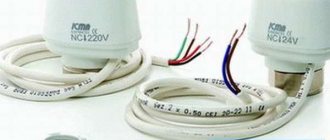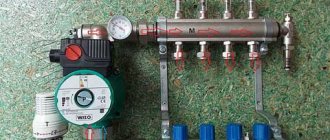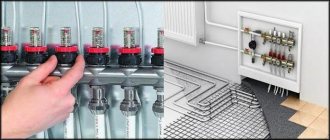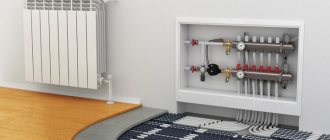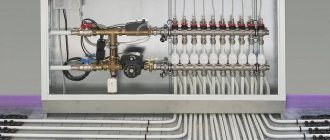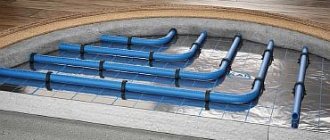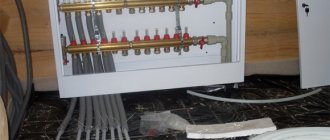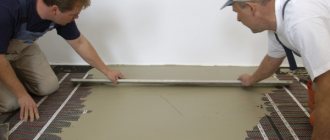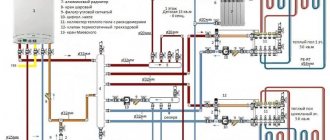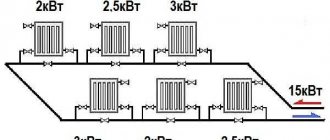Among the numerous equipment that is involved in the operation of underfloor heating systems, you can find a small device that plays a vital role in controlling and adjusting the heating system. This is a servo drive, an electromechanical device, without which automatic temperature control for a warm water floor is not possible.
The device is based on an electrothermal reaction to a change in the heating temperature of the coolant in the main supply pipe and subsequent mechanical action, which together ensures the opening or closing of the flow of hot water into the heating circuits. Servo drives or servomotors, officially in the language of professionals the device is called an electrothermal servo drive, are present today in almost all autonomous heating systems. New suburban residential buildings, cottages and dachas equipped with heated floors are equipped with heated floors, which are controlled by servo drives. It is the servo drive installed on the manifold for underfloor heating that performs the task of regulating the flow of coolant in the water floor heating system.
Existing types of servos today
Among the regulators that exist today and have become widespread in everyday life, the following servos are found. All devices can be divided into several types. Each type has a different operating principle and functionality. There are two types of device design:
- closed;
- open.
By the names you can judge the principle of operation. Enclosed servos typically remain open when no power is supplied. The incoming signal activates the mechanical part, blocking the access of water to the system. For open-type devices, the operating principle is reverse. In the normal state, the servo drive is closed; only when a signal is received, the mechanical part is activated, opening the flow of water into the pipeline. You can judge which type is best suited for domestic use by assessing the capabilities of your own heating system and the climatic conditions outside the window. Normally open servos are most often used in our country.
Note: if the device fails, the coolant in the pipeline continues to circulate, leaving the floor warm for a certain time. This feature is especially relevant for country houses located in a cold climate zone.
*
According to the method of power supply, servomotors are divided into devices powered by a constant flow voltage of 24V and devices connected to a regular AC power supply of 220V. Servo drives with 24V power supply are equipped with inverters.
Often consumers use another, rather rare type of device. We are talking about devices that are set to their normal position depending on the technological requirements of the heating system. Such servos are called universal and can change functionality from a normally open state to a normally closed state, and vice versa.
All three types of servomotors can be connected to the collector. The only condition is the correct setting, balancing and operating conditions of the heating system.
Scope of application
In a heating system, it can be installed in various places, for example, if it is necessary to regulate the flow of coolant into the heating device, it is installed on the supply pipeline. But the servo drive of the heater damper will allow you to regulate the flow of air into the boiler furnace, in other words, the heater power will be adjusted (read also the article “Modern heating Terem - a high level of quality at an affordable price”).
Adjusting the room temperature is much more often done using two methods:
- through thermostats - a good option if heating radiators are used. Under such conditions, regulators are installed in front of each battery and automatically regulate the flow of coolant into the radiator;
- via a servo drive - much more often used when it is necessary to regulate the temperature of heated floors.
Note! Servo drives can be installed on the heating manifold comb instead of simple thermal heads.
In the case of heated floors, it is especially important to keep the coolant no higher than a certain temperature. If, for example, you regulate the supply of coolant using simple thermostats, then when starting the system, a situation may arise when warm water is sent into the pipes. As a result, it will not be difficult to walk on the floor uncomfortably for some time, and some of the pipes may also fail.
Installing a servo drive with a 3-way valve upstream of the manifold will avoid this. In most cases, this is what I do, especially since the price for the device is minimal.
Criteria for selecting the type of servo drive
In this section we will try to answer the question. What is the basis for the choice of devices of one type or another?
If you decide to equip your “warm water floor” heating system with servo drives, take into account the operating parameters of your heating. In what position should the valve be most of the time? In a situation where a heated floor is your main option for heating residential premises, when hot coolant constantly enters the pipeline, rely on a normally open servomotor. This type is ideal during a long heating season.
Note: in case of interruptions in the electrical supply, failure of the device will not stop the circulation of warm water in the heating water circuits. The heated floor will continue to be supplied with treated water as a coolant.
*
For regions with warm climates, a normal closed servomotor is suitable. If you are not afraid of defrosting the heating circuit, and you periodically turn on the underfloor heating, this device will cope with its functions quite well.
Important! The servo drive for heated floors with smooth adjustment has an electronic regulator. Such devices respond more accurately to changes in the temperature of the coolant flow, smoothly moving the rod to the required position. Servomotors with smooth adjustment are designed for heated floors, in which it is often necessary to dose the volume of incoming flow.
In most cases, such devices are not used in home heating systems with underfloor heating. Therefore, when purchasing, pay attention to whether or not the installation of an electronic regulator is required for the device. If the instructions say that such equipment is necessary, then you are dealing with an electronic servo drive. Let’s say right away that using such a device at home is impractical and unprofitable.
Be sure to read: how to make a water floor from a gas boiler?
Assembly of the unit
The servo drive is installed on the finished collector assembly according to the following scheme:
Equipment diagram for heated floors
- The device can be installed in any position, regardless of whether it is normally closed, open or universal. But before the first switching on, the drive must be in the open state.
- Check the compatibility of the valve and servomotor using a template. It can be found on the device box.
- A threaded adapter (included) is installed on the valve. Correct installation is confirmed by snapping the latch.
To install the drive, you do not need to use any additional tools. Also, there is no need to use any sealing materials in the threaded connection. The electrical connection of the drive must be carried out according to the diagram provided by the manufacturer. You can find it in the operating instructions. To dismantle the servo drive, you need to press on its housing from the side and pull it up. This will cause the device to disconnect from the adapter.
Design and principle of operation of servomotors
The main working element of the servo drive is the bellows.
Those. the same part as in the three-way valve. A small, sealed cylinder with an elastic body is filled with a substance that is sensitive to temperature. Depending on whether the temperature increases or decreases, the volume of the substance changes accordingly. The figure - diagram clearly demonstrates the structure of the servomotor, where the bellows occupies the main place. The bellows is in close contact with the electric heating element. Receiving a signal from the thermostat, the heating element is switched on from the mains and starts working. Inside the bellows, the substance is heated and increases in volume. Thus, the cylinder, which has increased in size, begins to put pressure on the rod, changing its position and blocking the path of coolant flow. Evaluating the operation of the servo drive, we can conclude that the device is not equipped with any motors, it does not have any gears or transmission links. The usual working connection is “thermal energy and electricity”. Hence the common name for the devices, thermoelectric regulators.
In order for the valve to become open again, the entire process is repeated only in the opposite direction. Lack of power causes the heating element to stop working. Consequently, the substance inside the cylinder cools, decreasing in volume. The pressure on the rod decreases, it rises, acting on the valve, and, consequently, hot water access to the system opens.
Note: the substance placed inside the cylinder is toluene, which has high thermodynamic characteristics. The electric heating element is a nichrome thread.
Having become familiar with the principle of operation of the device, it is important to remember that the mechanical action of the valve requires a certain time. Despite the fact that when a signal is received from the thermostat, the heating element begins to heat the substance inside the cylinder. The time required for changes in the physical state of the liquid is 2-3 minutes, so the valve is not activated immediately.
For reference: when choosing a servo drive model, pay attention to the parameters of the heating element and the heating time of the liquid specified in the device passport.
*
Unlike heating, cooling of a liquid occurs more slowly. To the reverse process, i.e. Closing the valve will no longer take 2-3 minutes, but 10-15 minutes. If overheated, each servomotor should automatically turn off. For this purpose, the design provides an emergency shutdown mechanism.
For example: the servos used in the operation of the collector group are not all equipped with cylinders and cylinders with a substance. There are models in which this role is played by thermocouples, resembling a spring or plate, which heat up under the influence of the same heating element. Expanding, these parts again act on the rod, ultimately bringing the valve into working condition. You can determine what position the valve is in by changing the appearance of the servomotor. The retractable element signals the operation of the device. If this does not happen, it means that your device is not connected correctly or the heating system is not working properly.
For reference: a servomotor that is hot to the touch means that in this case the device is closed and turned off. If the device is cool to the touch, therefore, the valve is open, the coolant circulates normally through the water circuits of the heated floor.
More about the design
By design, servo drives can be divided into 2 groups of devices – electromechanical and electrothermal. In the first, mechanical gearing is used to set some part in motion. In electrothermal devices, instead, the property of a liquid (gas, solid substance) to change its quantity when heated is used, and they are used in heating systems.
When choosing a specific model, you need to know the designations used; you will see options such as:
- normally open/closed;
- voltage 230 or 24 V.
Everything is clear with voltage - 230 V means powering the device from the mains, and 24 V means using batteries. But open/closed are directly related to the operating mode and scope of application of the device.
- the normally closed type, when the circuit is closed, releases water through a section of the pipe, just this type is used in space heating;
- normally open - on the contrary, when the circuit is closed, it blocks the movement of the substance through the pipe; such devices are used mostly in air conditioners and refrigeration equipment.
Device and principle of operation
The main element of this device can be called a sealed chamber with a corrugated wall. This chamber may contain a gas, liquid, or solid substance - when heated, it will change the dimensions of the bellows (sealed chamber) and regulate the flow of the substance through the pipe.
During operation, a thermostat located anywhere in the room signals to the servo drive that the temperature exceeds the optimal one. The circuit closes and current begins to flow through it.
Along with this, the bellows heats up and elongates. When extended, the bellows begins to put pressure on the valve stem, reducing the passage opening in the pipe.
The design is spring-loaded, so that after the chain opens again and the bellows cools, the spring will return the pusher to its original position, and the passage hole will increase in size.
Installation Features
When installing the servo drive independently, the instructions will look like this:
- First, a thermostat is installed in the room - it will record changes in air temperature;
- after this, a two- or three-way valve is installed (the highlights of each type of valve are discussed below);
- A servo drive is installed specifically on the valve and connected to the thermostat. The device is receiving power.
Note! In 4-wire servos, 1 contact is provided for possible connection of other devices.
If all the connection work has been completed correctly, the LED on the servo drive head should light up; based on its color, it is possible to draw conclusions about the position:
- light blue color indicates that the device is now de-energized, in other words, it will be in the open state;
- The green indicator informs that voltage is supplied to the device, in other words, the servo drive is closed.
Application of two- and three-way valves
The servo drive can be used with two-, three- and four-way valves. In heating systems, the first 2 types of valves are much more often used.
Two-way valves with a servo drive are, in most cases, installed in front of radiators. Such a device has only an inlet and an outlet, and changing the passage hole allows you to regulate the flow of coolant through the valve. Installation of the control device is done by hand.
Three-way ones provide significantly more chances. Installing a servo drive allows you not only to regulate the coolant flow through it, but also, if necessary, to isolate the heating circuits from each other.
Note! Separation of heating circuits is simply necessary when using simple radiator and low-temperature heating (warm floors).
During temperature control, the servo drive on the 3-way valve can, for example, organize the addition of water from the return line into the supply pipe. This gives a 100% guarantee that excessively warm coolant will not enter the heating device.
Servo drive installation. Features and nuances
Before installing the servo drive, decide what type of thermostat the device will have to interact with. In cases where the thermostat controls the operation of one water circuit, both devices are directly connected to each other by wires. When it comes to using a multi-zone thermostat, a device that serves several pipelines at once, the servomotors are connected as follows.
*
To correctly connect all the wires and terminals, a heated floor switch is used. The functions of this device include connecting and connecting devices for various purposes into a single circuit. In addition to the distribution and communication functions, the switch also plays the role of a fuse. In situations where all shut-off valves of the water circuits are closed, the switch turns off the power to the circulation pump.
The switch is very convenient in cases where heated floors are powered by an automated autonomous gas boiler. The figure shows how thermostats and servos are connected to a single control system.
Tips for connecting
The entire system may not work efficiently if the device is not installed correctly. Therefore, you should connect the servomotor carefully, being aware of all the responsibility.
The device is installed on the manifold valves. There is no more precise diagram for connecting it to the system. Much depends on the chosen thermostat. If it is possible to control the thermostat with only one circuit, the servo drive for heated floors can be connected directly to it. When the thermostat has the function of working with several circuits, the wires should be routed into certain terminals.
The most common types of servomotors have only two wires. One receives zero, the second receives phase. But when one phase wire is missing, the device will perform only one specific function (it will either close the valve or open it).
It must be said that after the advent of new devices and devices, managing heated floors has become even easier.
Servo drive installation location, thermostatic valve installed on the manifold.
Important! When the heating system operates underfloor heating from a solid fuel boiler, a switch function such as turning off the pump can stop the heating device itself. Installing a bypass and bypass valve will allow you to avoid stopping the pump and running the heater idle.
Summarizing
The use of servo drives allows you to achieve high flexibility in adjusting the heating system. At the same time, the cost of such a device is low, and the ease of installation only adds to its popularity. Such a heating system will allow you to adequately and quickly respond to the slightest change in temperature in the house (see also the article “Installing heating: tips for choosing components of an autonomous system”).
The video shows an example of installing a servo drive on a heating manifold.
Did you like the article? Subscribe to our Yandex.Zen channel
conclusions
It should be noted that thanks to the advent of modern devices and devices, managing and adjusting heated floors has become a commonplace and simple process. The design of many devices used to operate heating circuits is not particularly complex. The operating principle of many components and assemblies is also clear. This can be said with confidence about servos. The devices are mostly reliable, practical and easy to use. Thanks to servomotors, it has become possible to fully automate the control system for heated floors, making the conditions for using heating equipment simple and understandable.
By choosing a simpler option, you can get by with installing conventional control valves. Automatic regulators, temperature sensors and servos are a category of devices that work for your comfort and safety. Installing additional devices, such as a switch and a bypass valve, will make your heating system as efficient and safe as possible.
Review of popular models
Servo drives for water heated floors are produced by different manufacturers. Each model has its own characteristics.
VALTEC
VALTEC is a manufacturer of devices for water and heating supply for the home. A group of Russian and Italian specialists is working together to create products. VALTEC produces the following drives to regulate the operation of a floor-type heating system:
- TE3042.A. Belongs to the group of normally open. Designed to control valves of climate systems using commands that will be set by a thermostat, controller or manual switch. Device power – 2 W, conductor cross-section – 0.75 sq. mm. The connecting size is M30x1.5;
- TE3061.0. This is a normally closed electrothermal device. Designed for three-way valves. The operation of the device is possible due to the thermal expansion of the liquid - toluene. Drive power – 2 W, conductor cross-section – 0.22 sq. mm;
- TE3041A.0. The device works thanks to the presence of liquid in the body, which expands under the influence of temperature. Belongs to the group of normally open. Connection to the valve occurs through an adapter, which is included in the kit. Unit power – 1.8 W, conductor cross-section – 0.75 sq. mm.
Watts
Watts is the world's leading manufacturer of heating equipment of various formats. It is distinguished by high quality, affordable price and efficiency. Servo drives from Watts are models with an electromagnetic motor. Popular series:
- 22C. It is installed on the return pipeline valve and regulates the flow of coolant into the underfloor heating system. Power is 2.5 W. Depending on the model, the 22C series includes normally open and closed devices. Protection class – IP44;
- 22СХ. They belong to electrothermal devices to ensure the efficient operation of water heated floors. There are normally closed and open models. The level of power consumption in normal operation is 1.8 W. The operating temperature of the liquid in the system is +110°C;
- 26LC. Electrothermal drives for the collector. There is an LED indicator on the case that indicates its operating mode. If the green light comes on, voltage is supplied to the drive, blue light means the device is open.
REHAU
Drives for adjusting the operation of water heated floors from a German manufacturer. They combine innovative developments and proven quality over the years. The most popular models from REHAU:
- UNI for 230, 24 V. The device is mounted on the valves of the manifold group using a special adapter. Applies to normally closed devices. Control over the operation of the drive is carried out through an indicator. Connecting cables with a cross section of 2x0.5 sq. mm;
- Drive 230, 24 V. When de-energized, the valve is in the closed state. To control the functioning of the device, a light indicator is placed on the case.
LUXOR
The Italian company LUXOR specializes in the production of water shut-off valves and systems for regulating the temperature of the heating system for the home. The installed collector group will include an SM 1347 drive. It is designed to regulate the temperature of the supplied coolant for a warm water floor. Main technical characteristics of the device:
- power supply – 24 V;
- The operation of the device is provided by a stepper motor. Its control is electronic;
- there is an LED indication on the case that indicates the operating mode;
- installation takes place in a straight position - vertical or horizontal;
- maximum temperature in the system – +100°C;
- cable 1.5 m long;
- device storage temperature – from 0 to +50°С;
- The body is made of synthetic materials. Its color is gray;
- Warranty available - 2 years.
Regardless of the model chosen, installation of the servo drive and its operation must be carried out in accordance with the manufacturer’s recommendations. These can be found in the instructions for the device. After installing the drive and all system elements, they begin to use them after full testing.
